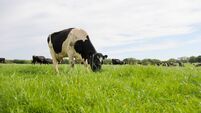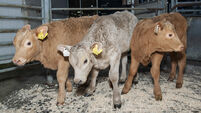Brian Reidy: What are your feeding options for stock for the coming winter?

Obviously, value for money must be a priority, but you must also consider if the feed is suitable for the animals you want to feed and if you have the facilities to store and feed it properly, writes ruminant nutritionist Brian Reidy.
The weather really makes the National Ploughing Championship, and thankfully, the rain gods played ball.
It is a pleasure to walk around the stands when the conditions underfoot are good. On a side note, it is such a pity to see very few cattle there anymore and also so few actual farming machines.
The dark evenings are now upon us, and plans for winter feeding are well advanced around the country. We will soon be approaching the last grazing rotation on many farms.
After a very wet end to August and start of September, the weather has settled to allow for the last of 2025 silage to be saved, and grass utilisation has improved significantly too.
As we head into October, attention will turn to preparing for housing and the winter-feeding plan. Grazing conditions are excellent at present, so this should mean most are a bit away from housing stock just yet.
However, in beef herds, advanced bullocks, heifers and young bulls would benefit from housing at this stage as grass will barely provide above maintenance energy.
In dairy herds, freshly calved cows and higher-yielding spring cows would perform better if housed, while autumn breeding heifers should be housed soon.
The first thing to always do is establish your total winter requirements and then work out how much feed you currently have in your yard. I will cover silage and straw requirements next week in detail.
At this time of year, I always get lots of queries from customers regarding feeds that they are being offered but have never fed before. In the last few weeks, I have had queries about brewing and distilling by-products, beet, maize silage and whole crop.
When discussing all of these feed options, there are many things to consider. Obviously, value for money must be a priority, but you must also consider if the feed is suitable for the animals you want to feed and if you have the facilities to store and feed it properly. One size does not fit all in this regard.
Storing and feeding ingredients that you have never fed before or haven’t fed for a long time takes good planning and appropriate infrastructure.
The storage and handling of moist feeds will require appropriate walled storage facilities, if you want to avoid huge storage and feed-out losses, along with the risk of moulds and mycotoxins causing animal performance and health issues.
Ideally, veg/potato wastes need to be fed fast to avoid spoilage, so you need to be feeding a large number of animals to get through each load in a timely manner.
For brewing and distilling by-products, having a long, narrow and low-walled clamp will allow you to consolidate the feed, eliminate oxygen from it and ultimately allow you to feed all of the material that was delivered. If these feeds are poorly stored and managed, the losses are big, and the risks to animal health and performance can be big.
For maize silage, is it to be clamped in your yard or delivered over the winter? Be careful with maize delivered over the winter; it must be ensiled properly after delivery, otherwise you will have significant spoilage and waste.
Maize is so easy to re-ensile and can be rolled in a clamp once delivered at any time, unlike grass silage, which can’t be re-pitted. Similar recommendations would exist for whole crop.
In all cases, if maize or whole crop is being moved for re-pitting, any spoilage on the shoulders and top of the pit must be removed before the trailers are loaded, to avoid that spoilage from being distributed through the new clamp.
Each year, I get asked to assess the ripeness of maize crops for customers. Crops are mostly excellent with massive yield and quality potentials this year. Currently, many crops are a bit away from harvest and patience is always needed at this time of year when making the decision to harvest maize.
From what I have seen this year, crops are still quite green and will need time to die back before being fit. The whole crop dry matter when assessing its readiness for cutting is the key determinant when deciding when to harvest.
Some crops are currently fit or have already been harvested, don’t let that decide if you will cut. Assess your own crop and get help with this from someone who knows what a ripe crop looks like.
A crop that is harvested at low dry matter will result in massive nutrient and dry matter losses in run-off.














